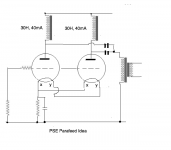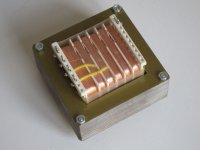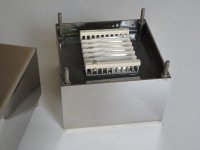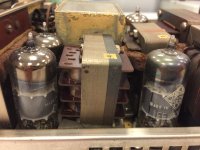As an exercise in using up parts on the shelf, I'm considering a 300b SE amp in parafeed. I'm not saying this will be optimised in any way, just that hopefully it might work moderately well. I'm sure many of you have redundant PP OPTs in cupboards, so it's a theoretical choice. Mine are 6.6K.
Thinking of a parafeed choke, my eyes fell on four 157G Hammond chokes, 30H and 40mA. These could be used in series for 60H at 40mA or in parallel for 15H at 80mA. I've tried a single one with driver tubes and the sound is pretty OK - it's used in the Hagerman Tuba. Various other Hammond possibilities. I also have some 10H at 100mA which could be used in series for 20H at 100mA. A proper choke would be better of course, but that would be where the costs would start to rise.
Again, the PP OPT isn't optimised and a proper one would be a lot more expensive.
Any fans of trying out a "300b SE parafeed on the cheap" or am I being a bit fanciful here? I've tried a parafeed headphone amp which was nice and used a 157G and a Lundahl LL1689/PP OPT, but not a 300b SE. I'm open to the idea of a 2a3 version as well.
Thinking of a parafeed choke, my eyes fell on four 157G Hammond chokes, 30H and 40mA. These could be used in series for 60H at 40mA or in parallel for 15H at 80mA. I've tried a single one with driver tubes and the sound is pretty OK - it's used in the Hagerman Tuba. Various other Hammond possibilities. I also have some 10H at 100mA which could be used in series for 20H at 100mA. A proper choke would be better of course, but that would be where the costs would start to rise.
Again, the PP OPT isn't optimised and a proper one would be a lot more expensive.
Any fans of trying out a "300b SE parafeed on the cheap" or am I being a bit fanciful here? I've tried a parafeed headphone amp which was nice and used a 157G and a Lundahl LL1689/PP OPT, but not a 300b SE. I'm open to the idea of a 2a3 version as well.
Last edited:
Andy,
The quality of parafeed choke is at least as important than OPT (and capacitor ).
).
If you use -in terms of audio- mediocre smoothing chokes, the result will be so mediocre.
Few (maybe ten) years ago I tried -good- CCS loaded 300B and good SE transformer as parafeed OPT. The overall result was disappointing (lifeless presentation), but it's my opinion.
I tried large inductance -audio, expensive- chokes at moderated -30mA- current as 801a anode choke in parafeed connection, with excellent presentation .... but the output was only 1W. pp
pp
The quality of parafeed choke is at least as important than OPT (and capacitor
If you use -in terms of audio- mediocre smoothing chokes, the result will be so mediocre.
Few (maybe ten) years ago I tried -good- CCS loaded 300B and good SE transformer as parafeed OPT. The overall result was disappointing (lifeless presentation), but it's my opinion.
I tried large inductance -audio, expensive- chokes at moderated -30mA- current as 801a anode choke in parafeed connection, with excellent presentation .... but the output was only 1W.
You might find using a resistor as the plate load interesting. Of course, you have to double the B+. With a 300B, that would be higher that what I would feel comfortable with using.
Here are a couple of examples with lower voltages, first with a 6V6 and secondly with a 6C33C.
Audio ratbag: Lumiere
Audio ratbag: Cat Vomit Special - a 6E5P / 6C33C parafeed amp
It's also possible to use an autoformer as the output transformer.
ray
Here are a couple of examples with lower voltages, first with a 6V6 and secondly with a 6C33C.
Audio ratbag: Lumiere
Audio ratbag: Cat Vomit Special - a 6E5P / 6C33C parafeed amp
It's also possible to use an autoformer as the output transformer.
ray
If you use -in terms of audio- mediocre smoothing chokes, the result will be so mediocre.
Why is that? Its just a simple anode coil. Nothing special in winding technique like in audio output trans.
A typical B+ choke is made to work with a full wave rectifier or bridge.
Full wave is either 100Hz, or 120Hz, depending on your 50Hz or 60Hz power mains.
Most usually, the choke rated inductance and rated DC current are for 100Hz or 120Hz filtering operation.
There will not be enough laminations for operation at 20Hz or 30Hz at the current rating of the choke.
There is also the distributed capacitance of the windings in parallel with the inductance.
That can take effect at high frequencies.
All that being said, I have used some Hammond B+ filter chokes in two circuit locations:
1. Used as a current sink for a pair of cathodes in a self inverting push pull output stage (did that on several different amplifiers).
2. Used as a current source for a single ended parafeed amplifier (only tried that once).
I found that they worked quite well on the self inverting push pull amplifier output stage.
I do not remember them working quite as well for the plate load of a SE parafeed output.
They
Full wave is either 100Hz, or 120Hz, depending on your 50Hz or 60Hz power mains.
Most usually, the choke rated inductance and rated DC current are for 100Hz or 120Hz filtering operation.
There will not be enough laminations for operation at 20Hz or 30Hz at the current rating of the choke.
There is also the distributed capacitance of the windings in parallel with the inductance.
That can take effect at high frequencies.
All that being said, I have used some Hammond B+ filter chokes in two circuit locations:
1. Used as a current sink for a pair of cathodes in a self inverting push pull output stage (did that on several different amplifiers).
2. Used as a current source for a single ended parafeed amplifier (only tried that once).
I found that they worked quite well on the self inverting push pull amplifier output stage.
I do not remember them working quite as well for the plate load of a SE parafeed output.
They
andyjevans idea of using two output tubes is quite a good idea,
as long as you are willing to use two output tubes.
Although the two coupling caps do effectively put the chokes in AC parallel, which makes the inductance 15H . . .
But the 15H AC impedance is driven by parallel tubes, so the effective load inductance to each individual tube is 30H.
That was a good call on andyjevans part.
I never would have thought of that, but I will not forget it now that I have seen it.
as long as you are willing to use two output tubes.
Although the two coupling caps do effectively put the chokes in AC parallel, which makes the inductance 15H . . .
But the 15H AC impedance is driven by parallel tubes, so the effective load inductance to each individual tube is 30H.
That was a good call on andyjevans part.
I never would have thought of that, but I will not forget it now that I have seen it.
Audio output transformer winding is both an art and a science.
One thing designers do is try to minimize Leakage Reactance.
But for a plate load choke, what you actually want is lots of Leakage Reactance.
Some will put lots of physical space in the separation of each winding layer, to increase the leakage reactance.
The large space between the winding layers also reduces the total distributed capacitance of the plate choke.
I would not be too sure that all "plate" load chokes are built that way (more expensive to manufacturing).
One thing you do have going for your quick and inexpensive parafeed amp is that at the typical 300B quiescent current, the plate impedance, rp is quite low, 700 Ohms.
That low rp can help overcome some 'not so high' load impedances.
Safety hint:
Be sure to use a very high voltage parafeed coupling cap, at the very least it should be at least 2x the B+.
I used a 2kV rated cap, since my B+ was about 400V, and I did not have anything between 600V and 1000V.
If the speaker impedance is high at the same frequency as the resonance of the combination of choke, cap, primary, the voltage can go higher than 2X B+ volts.
Do not use an electrolytic as a parafeed coupling cap.
Build your parafeed and see how it works. Let us know.
Happy listening!
One thing designers do is try to minimize Leakage Reactance.
But for a plate load choke, what you actually want is lots of Leakage Reactance.
Some will put lots of physical space in the separation of each winding layer, to increase the leakage reactance.
The large space between the winding layers also reduces the total distributed capacitance of the plate choke.
I would not be too sure that all "plate" load chokes are built that way (more expensive to manufacturing).
One thing you do have going for your quick and inexpensive parafeed amp is that at the typical 300B quiescent current, the plate impedance, rp is quite low, 700 Ohms.
That low rp can help overcome some 'not so high' load impedances.
Safety hint:
Be sure to use a very high voltage parafeed coupling cap, at the very least it should be at least 2x the B+.
I used a 2kV rated cap, since my B+ was about 400V, and I did not have anything between 600V and 1000V.
If the speaker impedance is high at the same frequency as the resonance of the combination of choke, cap, primary, the voltage can go higher than 2X B+ volts.
Do not use an electrolytic as a parafeed coupling cap.
Build your parafeed and see how it works. Let us know.
Happy listening!
Last edited:
For what it's worth, here are some combinations I have used - some experimental, some commercial:
10H, 90mA Triad loading a pair of TV vertical output triodes - about 50-60mA total - into a Dynakit ST-70 OPT (4.2K? Something like that). Disappointing, possibly because the PP transformer has some internal resonances if the centertap isn't grounded.
10H, 90mA Triad running 50mA as plate load for a 2A3, feeding a 4K output transformer. Doesn't seem like much, but it was quite satisfactory - IIRC, the bass was good down to 45Hz or so.
30H, 40mA (yes, the 157G) loading a single TV tube running 28mA, into an 8K output transformer. Got about 2 watts of pretty decent sound.
15H, 75mA (Hammond 158L) in a 2A3 at 50mA, 4K load. More bass than the 10H above, but ultimately went with 20H to get the bass down below 25Hz.
Usually the plate choke has around twice as many winding layers as the output transformer, so its capacitance is half as much - much less, if the OPT is heavily interleaved!
Notice that I used them at around 2/3 of rated current, to avoid saturation on large deep bass signals. I never did get around to determining experimentally how much current I could get away with.
Of course, more inductance almost always sounds better, but it gets pretty subtle above 5H per Kohm, and half of that is actually pretty good.
10H, 90mA Triad loading a pair of TV vertical output triodes - about 50-60mA total - into a Dynakit ST-70 OPT (4.2K? Something like that). Disappointing, possibly because the PP transformer has some internal resonances if the centertap isn't grounded.
10H, 90mA Triad running 50mA as plate load for a 2A3, feeding a 4K output transformer. Doesn't seem like much, but it was quite satisfactory - IIRC, the bass was good down to 45Hz or so.
30H, 40mA (yes, the 157G) loading a single TV tube running 28mA, into an 8K output transformer. Got about 2 watts of pretty decent sound.
15H, 75mA (Hammond 158L) in a 2A3 at 50mA, 4K load. More bass than the 10H above, but ultimately went with 20H to get the bass down below 25Hz.
Usually the plate choke has around twice as many winding layers as the output transformer, so its capacitance is half as much - much less, if the OPT is heavily interleaved!
Notice that I used them at around 2/3 of rated current, to avoid saturation on large deep bass signals. I never did get around to determining experimentally how much current I could get away with.
Of course, more inductance almost always sounds better, but it gets pretty subtle above 5H per Kohm, and half of that is actually pretty good.
Each coil has impedance, as a function of self reactance and copper resistance. You do not want to use a coil with a high Q in the AF. Most power chokes have a couple of KHz self resonance frequency.Why is that? Its just a simple anode coil. Nothing special in winding technique like in audio output trans.
Patrick Turner wrote excellent discussions, this is about chokes:
audiofilterchokes-page3
BTW -well designed- anode/plate choke has even more complex structure than OPT.
audiofilterchokes-page3
BTW -well designed- anode/plate choke has even more complex structure than OPT.
Attachments
For what it's worth, here are some combinations I have used - some experimental, some commercial...
Thank you Paul - your experience is invaluable here. Thanks for posting and keep an eye on the thread!
Thanks of course to euro21, 6A3 and all the other posters for making this thread interesting and informative.
.
Last edited:
Patrick Turner wrote excellent discussions, this is about chokes:
audiofilterchokes-page3
BTW -well designed- anode/plate choke has even more complex structure than OPT.
Euro21,
where are those multi chamber chokes available?
They remind me of the TAB V76 anode chokes.
Btw, the Turner tube amp pages are very interesting with lots of information, but they cause my PC virus watchdog to find a new virus on my computer (which was quickly moved to the trash folder).
Attachments
Last edited:
- Status
- This old topic is closed. If you want to reopen this topic, contact a moderator using the "Report Post" button.
- Home
- Amplifiers
- Tubes / Valves
- Parafeed SE 300b amp on the cheap.



